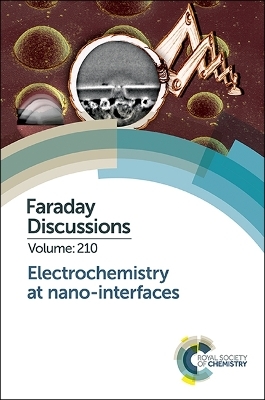
Electrochemistry at Nano-interfaces
Faraday Discussion 210
Seiten
2018
Royal Society of Chemistry (Verlag)
978-1-78801-375-8 (ISBN)
Royal Society of Chemistry (Verlag)
978-1-78801-375-8 (ISBN)
- Lieferbar (Termin unbekannt)
- Versandkostenfrei
- Auch auf Rechnung
- Artikel merken
ThisFaraday Discussion explores the modern methods used to design new nano-interfaces, probe the charge/energy transferring processes at the nano-interface, and promote applications including those involving single-molecule studies, single-nanoparticle electrochemistry and single-cell analysis.
The active nano-interface is important in electrochemistry because it constitutes the place where electron/ion transfer reactions occur coupled to extremely fast mass transport and under exquisite control of local conditions. Electrochemistry at nano-interfaces poses major fundamental and conceptual challenges in physical electrochemistry, while also being central to the emergence of real applications. Nano-interfaces are a major theme in energy transforming technologies (e.g. batteries, fuel cells, solar cells), electrochemical biosensors, diagnostic platforms, in bio-electrochemistry, and in nano-electrochemical mapping/imaging techniques. All of these areas face common challenges linked to the nano-interface concept. This Faraday Discussions meeting addresses these fundamental challenges, and also encourages cross-disciplinary interactions.
At this Faraday Discussion, we will discuss the theme of understanding the electrochemistry at nano-interfaces, including electron- and ion-transfer. We will explore the modern methods used to design new nano-interfaces, probe the charge/energy transferring processes at the nano-interface, and promote applications including those involving single-molecule studies, single-nanoparticle electrochemistry and single-cell analysis.
The rising issue lies in understanding the importance of nanostructures in nanopores and nano-electrodes; this is linked to the control of the nature of electrochemical performance and potentially revolutionizes both the understanding of electrochemical processes and the construction of new sophisticated functionalized nano-interfaces. In particular, we will aim to shed light on the development of new ultrafast current measurements as well as spatially resolved imaging tools, which have great relevance and interest for transient detection/imaging and for the measurement of charge transfer at nanostructured interfaces in many applications.
The active nano-interface is important in electrochemistry because it constitutes the place where electron/ion transfer reactions occur coupled to extremely fast mass transport and under exquisite control of local conditions. Electrochemistry at nano-interfaces poses major fundamental and conceptual challenges in physical electrochemistry, while also being central to the emergence of real applications. Nano-interfaces are a major theme in energy transforming technologies (e.g. batteries, fuel cells, solar cells), electrochemical biosensors, diagnostic platforms, in bio-electrochemistry, and in nano-electrochemical mapping/imaging techniques. All of these areas face common challenges linked to the nano-interface concept. This Faraday Discussions meeting addresses these fundamental challenges, and also encourages cross-disciplinary interactions.
At this Faraday Discussion, we will discuss the theme of understanding the electrochemistry at nano-interfaces, including electron- and ion-transfer. We will explore the modern methods used to design new nano-interfaces, probe the charge/energy transferring processes at the nano-interface, and promote applications including those involving single-molecule studies, single-nanoparticle electrochemistry and single-cell analysis.
The rising issue lies in understanding the importance of nanostructures in nanopores and nano-electrodes; this is linked to the control of the nature of electrochemical performance and potentially revolutionizes both the understanding of electrochemical processes and the construction of new sophisticated functionalized nano-interfaces. In particular, we will aim to shed light on the development of new ultrafast current measurements as well as spatially resolved imaging tools, which have great relevance and interest for transient detection/imaging and for the measurement of charge transfer at nanostructured interfaces in many applications.
Faraday Discussions documents a long-established series of Faraday Discussion meetings which provide a unique international forum for the exchange of views and newly acquired results in developing areas of physical chemistry, biophysical chemistry and chemical physics. The papers presented are published in the Faraday Discussion volume together with a record of the discussion contributions made at the meeting. Faraday Discussions therefore provide an important record of current international knowledge and views in the field concerned. The latest (2016) impact factor of Faraday Discussions is 3.588.
Processes at Nanopores and Bio-Nanointerfaces;
Processes at Nanoelectrodes;
Energy Conversion at Nanointerfaces;
Dynamics of Nanointerfaces
| Erscheinungsdatum | 30.10.2018 |
|---|---|
| Reihe/Serie | Faraday Discussions ; Volume 210 |
| Mitarbeit |
Sonstige Mitarbeit: Royal Society of Chemistry |
| Verlagsort | Cambridge |
| Sprache | englisch |
| Maße | 156 x 234 mm |
| Gewicht | 871 g |
| Themenwelt | Naturwissenschaften ► Chemie ► Analytische Chemie |
| Naturwissenschaften ► Chemie ► Physikalische Chemie | |
| Technik | |
| ISBN-10 | 1-78801-375-1 / 1788013751 |
| ISBN-13 | 978-1-78801-375-8 / 9781788013758 |
| Zustand | Neuware |
| Haben Sie eine Frage zum Produkt? |
Mehr entdecken
aus dem Bereich
aus dem Bereich


